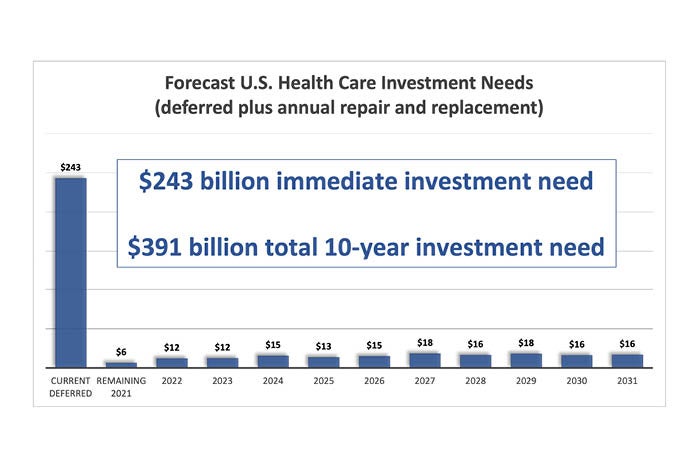AHA advocates for investments in aging health care infrastructure

Forecast estimates the total cost of deferred maintenance in 10 years without increased investment.
Image courtesy of Facility Health Inc.
As part of its American Jobs Plan, the Biden administration has laid out key objectives to “reimagine and rebuild a new economy.” The $2 trillion investment seeks to address critical needs such as rehabilitating the country’s crumbling infrastructure.
Springboarding off this effort, the American Hospital Association (AHA) sent proposals urging Congress to consider hospitals and health systems when passing legislation related to the plan.
According to the Department of Homeland Security, health care is one of 16 critical infrastructure sectors that help to maintain continuity during critical times, such as during the COVID-19 pandemic.
Each year, however, health facilities face the same challenges of aging infrastructure experienced by other sectors.
Research conducted by capital planning firm Facility Health Inc. (FHI), Grand Rapids, Mich., and commissioned by the American Society for Health Care Engineering (ASHE), a professional membership group of the AHA, shows that the average percentage of deferred maintenance — including exterior and interior architecture, as well as life safety, HVAC, mechanical, electrical and plumbing systems — across U.S. health care facilities sits around 41%. The current total amount needed to address that deferred maintenance today is projected to be $243 billion across the nation.
Mark Mochel, PMP, FCT, CSM, ACABE, co-founder and senior vice president at FHI, explains that although infrastructure currently in deferred maintenance status does not mean those assets are in imminent failure mode, it does mean that they have exceeded industry expected useful life based on age and/or condition, which does increase the probability of failure and risk to patients.
Based on FHI’s research, if the average percentage of deferred maintenance continues to increase at its current rate ($12 billion to $18 billion per year) the amount needed to catch assets up will increase to $391 billion over 10 years.
“If we do nothing and things continue to age at this rate without any increase in investment, we’re projecting that up to 68% of the infrastructure will exceed its expected useful life by 2031,” Mochel says. “However, if we increase our infrastructure investment over the next 10 years, we can not only prevent further aging, but reverse the trend.”
Jonathan Flannery, MHSA, CHFM, FASHE, FACHE, senior associate director of advocacy at ASHE, says that aging infrastructure is an inescapable fact that must be addressed.
“It’s just like your car. No matter how well you take care of it, as it gets older, it increases your chance of a breakdown,” he says. “And just like there are multiple options to address your car’s maintenance, there are many ways of addressing deferred maintenance in hospitals. Do you build brand new? Upgrade your utilities and infrastructure? Regardless of how much work and effort you put into maintaining a system, they are mechanical and will age, so you have to invest in them.”
The AHA’s proposal includes steps Congress can take to keep infrastructure from aging further, such as expanding and enhancing tax-exempt financing; ensuring adequate funding for the Hospital Preparedness Program; and building and renovation of behavioral health facilities.
Mochel explains that advocacy for infrastructure funding among leaders within and outside of the health care field has seen a growing cultural shift that recognizes proper functioning of infrastructure assets is integral to the performance of the clinical environment of care. COVID-19 then solidified that shift and understanding.
Using traditional financial models that weigh return on investment of, for example, a new boiler versus a new MRI machine, “the new MRI is going to win the return-on-investment battle all day long,” Mochel says. “However, once that boiler fails, an organization might easily spend $5 million to replace what would have been a $1 million project because now it is an emergency situation.
“So, when I talk with health care leaders, I ask them, ‘If there’s no return on investment from a boiler, then why do you fix it when it breaks?’” Mochel continues. “We help them see that infrastructure assets and clinical outcomes are linked. In my opinion, the infrastructure is a clinical asset as well.”




